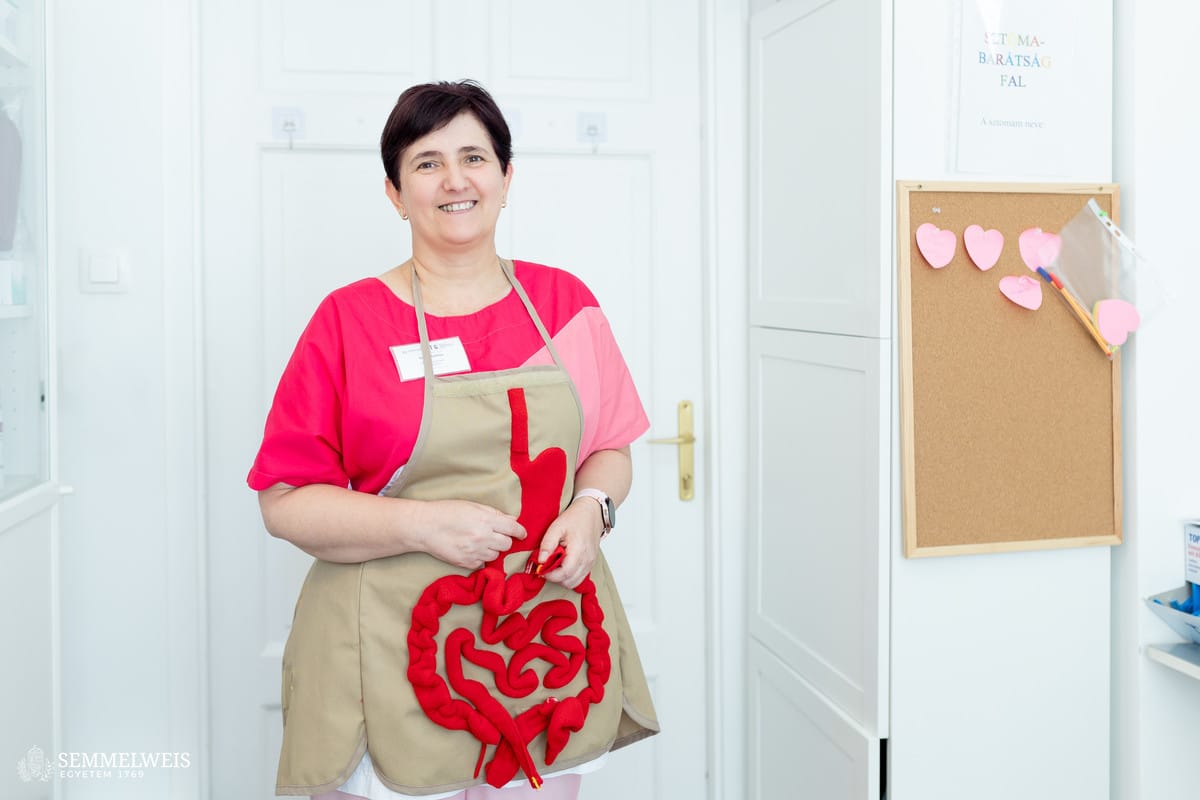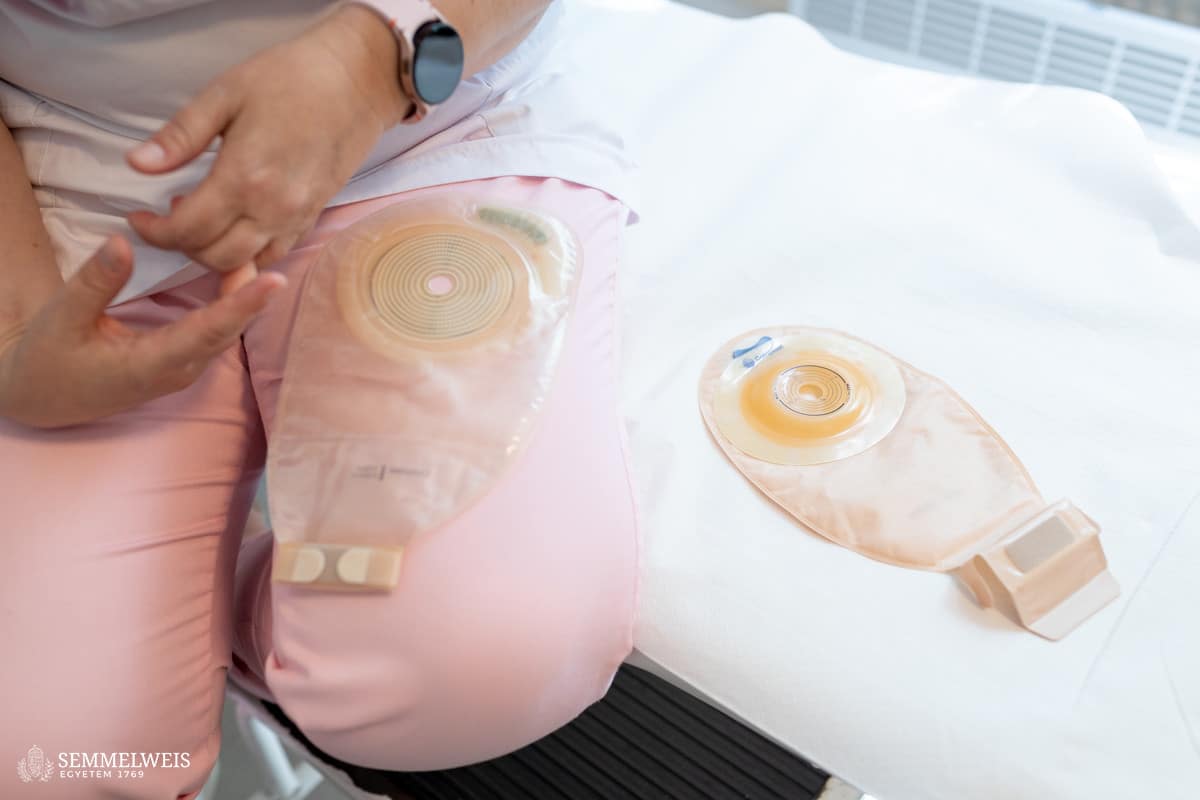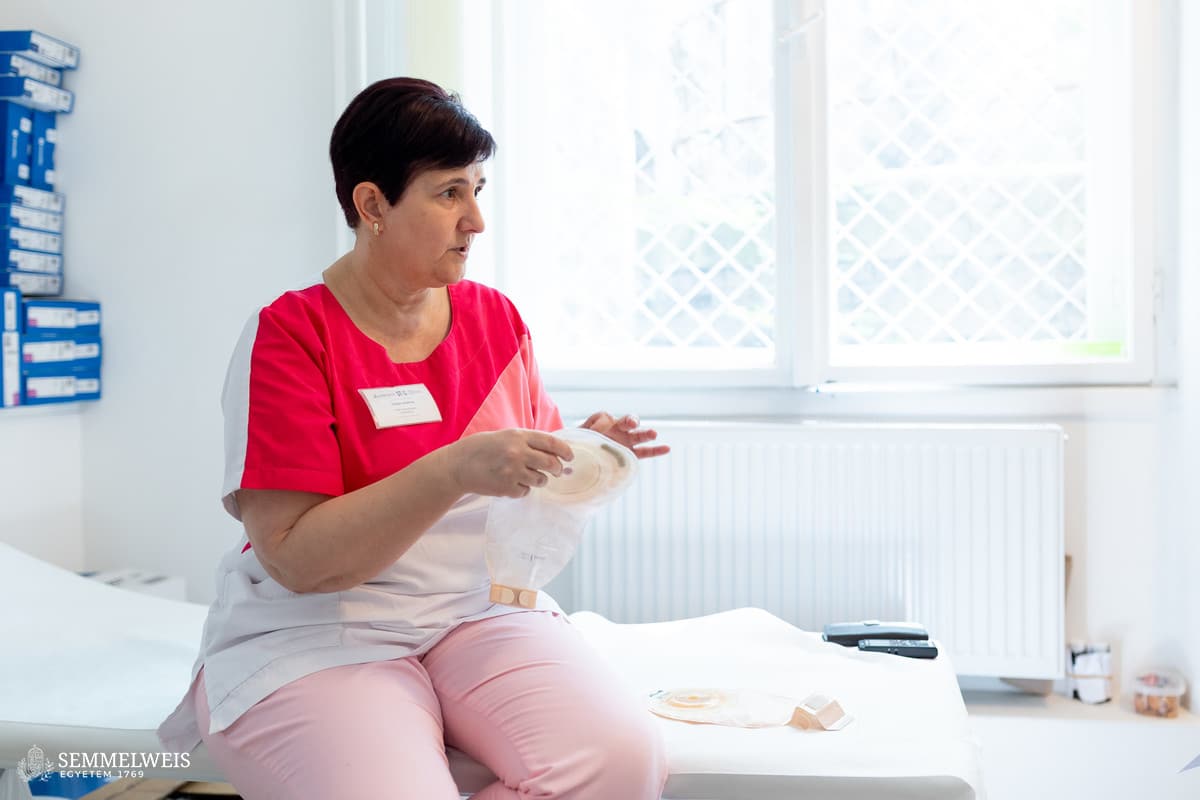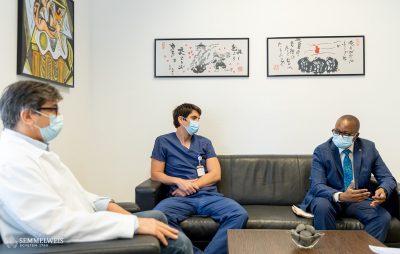 Judit, 50, works, runs, swims, hikes, travels, and is active in every way. She has been living with an ostomy system for a year, after sclerosing cholangitis destroyed several of her organs, and various treatments and therapies left their mark on her body. She has already had one liver transplant. Due to the progression of her underlying condition, she is now awaiting another. Despite this, she remains an infinitely optimistic person with a life-affirming personality. She recalled that, two years ago, when she had to have her colon removed due to the side effects of chemotherapy, she learned that she would need a stoma. Like many of her fellow patients, she initially thought that her life was over at the age of 47. However, the more research she did on life with a stoma, the more her desperation began to fade. From the outset, she received a great deal of support from stoma nurses, who provided her with practical advice and useful tips on everything from choosing the right ostomy pouch to mastering the necessary routines. She has been in contact with stoma care nurses since before her first stoma surgery. As she said, she could rely on them for support with everything.
Judit, 50, works, runs, swims, hikes, travels, and is active in every way. She has been living with an ostomy system for a year, after sclerosing cholangitis destroyed several of her organs, and various treatments and therapies left their mark on her body. She has already had one liver transplant. Due to the progression of her underlying condition, she is now awaiting another. Despite this, she remains an infinitely optimistic person with a life-affirming personality. She recalled that, two years ago, when she had to have her colon removed due to the side effects of chemotherapy, she learned that she would need a stoma. Like many of her fellow patients, she initially thought that her life was over at the age of 47. However, the more research she did on life with a stoma, the more her desperation began to fade. From the outset, she received a great deal of support from stoma nurses, who provided her with practical advice and useful tips on everything from choosing the right ostomy pouch to mastering the necessary routines. She has been in contact with stoma care nurses since before her first stoma surgery. As she said, she could rely on them for support with everything.
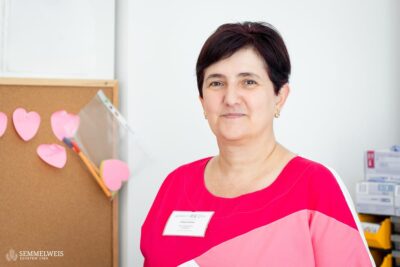 The relationship between the stoma nurse and the patient begins before the surgery and may continue until the end of the patient’s life. The patient’s future quality of life depends largely on stoma care nurses, whether they will be able to live their lives to the fullest and what late complications they will have to deal with, explained Andrea Orbán, STéG’s Head Stoma Nurse, who has been working in this field for more than 30 years.
The relationship between the stoma nurse and the patient begins before the surgery and may continue until the end of the patient’s life. The patient’s future quality of life depends largely on stoma care nurses, whether they will be able to live their lives to the fullest and what late complications they will have to deal with, explained Andrea Orbán, STéG’s Head Stoma Nurse, who has been working in this field for more than 30 years.
With a stoma, you can live a full life. You can go hiking, climb mountains, and give birth to and raise children. The key to achieving this is having a well-constructed ostomy system and a properly fitting product, as well as being a cooperative patient. – Andrea Orbán
“Before stoma surgery, we discuss with patients what it will be like to live with an ostomy system. We show them ostomy pouches, select the optimal device together, and determine the ideal location for the future stoma by testing several body positions, such as sitting, standing, and leaning forward,” explained the head stoma nurse at STéG, emphasizing that this not only reassured patients, but literature suggested that it also made it easier for them to accept their stoma, shortened their hospital stay, and helped them cope with their ostomy system.
Stoma nurses begin educating their patients in practice one or two days after surgery. “We use a mirror to show patients the opening in their abdominal wall – the stoma – as it is important for them to see what it should look like. We teach them how to empty and replace the pouch. All the necessary equipment is available in the stoma care room for practice. If their four- to five-day hospital stay is not enough for patients to master the steps perfectly, we are always available to them on the phone or in person at short notice, should they need immediate assistance,” emphasized Andrea Orbán. The department staff also asks patients for feedback when removing sutures. At this point, they refine the patients’ movements and adjust the device if necessary. According to her, most of the work involved in stoma therapy is educational, with the remainder focused on combating complications. They also work closely with surgeons, pediatric surgeons, gastroenterologists, urologists, dieticians, physiotherapists, and psychologists.
We perform between 240 and 280 stoma surgeries each year, and it is estimated that around 18,000 people with ostomies are living in Hungary.
 Emotional support is an important part of stoma therapy because receiving an ostomy system involves experiencing a loss that requires adaptation. “It is a challenging new life situation, even if the affected person realizes the necessity of acceptance. In such cases, a grieving process begins, and everyone embarks on a psychological journey,” explained Anita Juhász, a clinical psychologist at StéG. She added that psychologists at the hospital assist with this journey, even after discharge if necessary. “We recommend that our patients contact us before surgery to join our psychological preparation program. Consultation is voluntary; we cannot make it mandatory, but it is strongly recommended. This option is available to all patients at our department and includes a health assessment. For those about to receive an ostomy system, we pay special attention to stoma care and psychological preparation for life with a stoma. If necessary, we begin facilitating the acceptance process even before the surgery. Following the operation, we provide further counselling, low-intensity psychotherapy, as well as crisis management and support,” said Anita Juhász. Having a stoma affects the patient’s identity, body image, the experience of control over one’s body and life, lifestyle, and brings about changes in all these factors, which must be accepted, she emphasized.
Emotional support is an important part of stoma therapy because receiving an ostomy system involves experiencing a loss that requires adaptation. “It is a challenging new life situation, even if the affected person realizes the necessity of acceptance. In such cases, a grieving process begins, and everyone embarks on a psychological journey,” explained Anita Juhász, a clinical psychologist at StéG. She added that psychologists at the hospital assist with this journey, even after discharge if necessary. “We recommend that our patients contact us before surgery to join our psychological preparation program. Consultation is voluntary; we cannot make it mandatory, but it is strongly recommended. This option is available to all patients at our department and includes a health assessment. For those about to receive an ostomy system, we pay special attention to stoma care and psychological preparation for life with a stoma. If necessary, we begin facilitating the acceptance process even before the surgery. Following the operation, we provide further counselling, low-intensity psychotherapy, as well as crisis management and support,” said Anita Juhász. Having a stoma affects the patient’s identity, body image, the experience of control over one’s body and life, lifestyle, and brings about changes in all these factors, which must be accepted, she emphasized.
During hospitalization, the intervention takes place one to three times a week, tailored to the patient’s current condition and needs. Between consultations, patients may be given therapeutic homework assignments to help them process and practice new skills. Discharged patients are offered six consultation sessions; if further psychotherapy is required, they are referred to specialist care appropriate to their condition, the psychologist added.
Regarding acceptance, she refers to psychological research findings that suggest people who have experienced multiple losses in the past find it easier to cope with further losses. Anita Juhász explained that the level of education, intelligence, and socioeconomic status correlate with acceptance, but that personality structure and maturity are decisive factors in adaptation. Those who let go of control more easily find it easier to reach acceptance, she pointed out.
 Since fall 2022, stoma care nursing skills have been taught at STéG as an elective, accredited training program in semester-long courses. Eighty people have completed the training course, which has been offered four times so far. Nurses interested in the field arrived from all over the country to attend Semmelweis’s comprehensive stoma care course, which lasted a whole semester. Previously, they had only been able to acquire the necessary knowledge at targeted courses organized by the manufacturers of the equipment used in care. The training met expectations, covering all aspects of stoma care, including anatomical knowledge, knowledge of materials, and the psychological consequences. “In addition, we have managed to recruit an excellent and motivated team of instructors from at least ten different fields related to stoma care, and the team has recently grown into a cohesive unit,” said Dr. Balázs Bánky, Associate Professor at STéG and head of the stoma care team.
Since fall 2022, stoma care nursing skills have been taught at STéG as an elective, accredited training program in semester-long courses. Eighty people have completed the training course, which has been offered four times so far. Nurses interested in the field arrived from all over the country to attend Semmelweis’s comprehensive stoma care course, which lasted a whole semester. Previously, they had only been able to acquire the necessary knowledge at targeted courses organized by the manufacturers of the equipment used in care. The training met expectations, covering all aspects of stoma care, including anatomical knowledge, knowledge of materials, and the psychological consequences. “In addition, we have managed to recruit an excellent and motivated team of instructors from at least ten different fields related to stoma care, and the team has recently grown into a cohesive unit,” said Dr. Balázs Bánky, Associate Professor at STéG and head of the stoma care team.
Based on the experience from the first four semesters, they decided to launch the program in fall 2025 as a one-year, two-semester training course with an expanded curriculum and a longer duration. It will cover similar topics as before, but will discuss each subchapter in greater detail, added Dr. Balázs Bánky. He emphasized that the extension of the time frame was justified due to the increased emphasis on practical training. In addition to 52 hours of theoretical instruction, students participate in a focused, detailed, 40-hour practical training program and two consultations. They must gain experience at the bedside and in outpatient care, primarily at STéG, but also in their own field at their base hospital, and they must also present case studies, which is a prerequisite for admission to the exam, said the STéG associate professor.
First-hand advice on living life to the fullest with an ostomy pouch
 Judit first received a temporary colostomy to relieve pressure on her colon. “I learned how to manage it, went to the beach, went hiking, traveled to Greece, everything was fine, it didn’t even bother me when I was getting dressed,” she recalled, talking about her experiences from two years ago. “When my colon had to be removed, an ileostomy was created on my abdominal wall. This requires more attention in terms of diet and fluid intake than a colostomy, and it has to be emptied more often due to continuous discharge and changes in stool consistency. However, you can get used to it,” emphasized Judit, who also highlighted the help she received from stoma care nurses. Now that she has gotten used to it, her ileostomy no longer limits her activities, and she leads an active life just as she did before. She didn’t even have to update her wardrobe; the only important thing, she said, was to avoid low-waisted pants. She also goes swimming, whether it’s at a Greek beach or in a swimming pool. “I’ve come to accept that I have to live with this and not shut myself away,” she said, highlighting that many people limit their activities out of concern for what might happen if the pouch fell off. She feels that the stoma is a taboo topic in Hungary. Although there are more and more patients, many people have no idea what life is like with a stoma because of scary stories, fear, and a lack of information. In addition to the wealth of useful advice provided by stoma care nurses, she values the social media groups where those affected can share their experiences. When talking about fears related to skin damage, she shares her experience that an ostomy pouch which is cut out well and positioned correctly causes no problems, and apart from showering, no special care products need to be used. “A high degree of awareness is necessary, of course, but managing diabetes also requires attention,” Judit says, drawing a parallel with chronic diseases that are considered less frightening by the public.
Judit first received a temporary colostomy to relieve pressure on her colon. “I learned how to manage it, went to the beach, went hiking, traveled to Greece, everything was fine, it didn’t even bother me when I was getting dressed,” she recalled, talking about her experiences from two years ago. “When my colon had to be removed, an ileostomy was created on my abdominal wall. This requires more attention in terms of diet and fluid intake than a colostomy, and it has to be emptied more often due to continuous discharge and changes in stool consistency. However, you can get used to it,” emphasized Judit, who also highlighted the help she received from stoma care nurses. Now that she has gotten used to it, her ileostomy no longer limits her activities, and she leads an active life just as she did before. She didn’t even have to update her wardrobe; the only important thing, she said, was to avoid low-waisted pants. She also goes swimming, whether it’s at a Greek beach or in a swimming pool. “I’ve come to accept that I have to live with this and not shut myself away,” she said, highlighting that many people limit their activities out of concern for what might happen if the pouch fell off. She feels that the stoma is a taboo topic in Hungary. Although there are more and more patients, many people have no idea what life is like with a stoma because of scary stories, fear, and a lack of information. In addition to the wealth of useful advice provided by stoma care nurses, she values the social media groups where those affected can share their experiences. When talking about fears related to skin damage, she shares her experience that an ostomy pouch which is cut out well and positioned correctly causes no problems, and apart from showering, no special care products need to be used. “A high degree of awareness is necessary, of course, but managing diabetes also requires attention,” Judit says, drawing a parallel with chronic diseases that are considered less frightening by the public.
Anita Szepesi
Translation: Judit Szabados-Dőtsch
Photos by Attila Kovács, Boglárka Zellei – Semmelweis University


